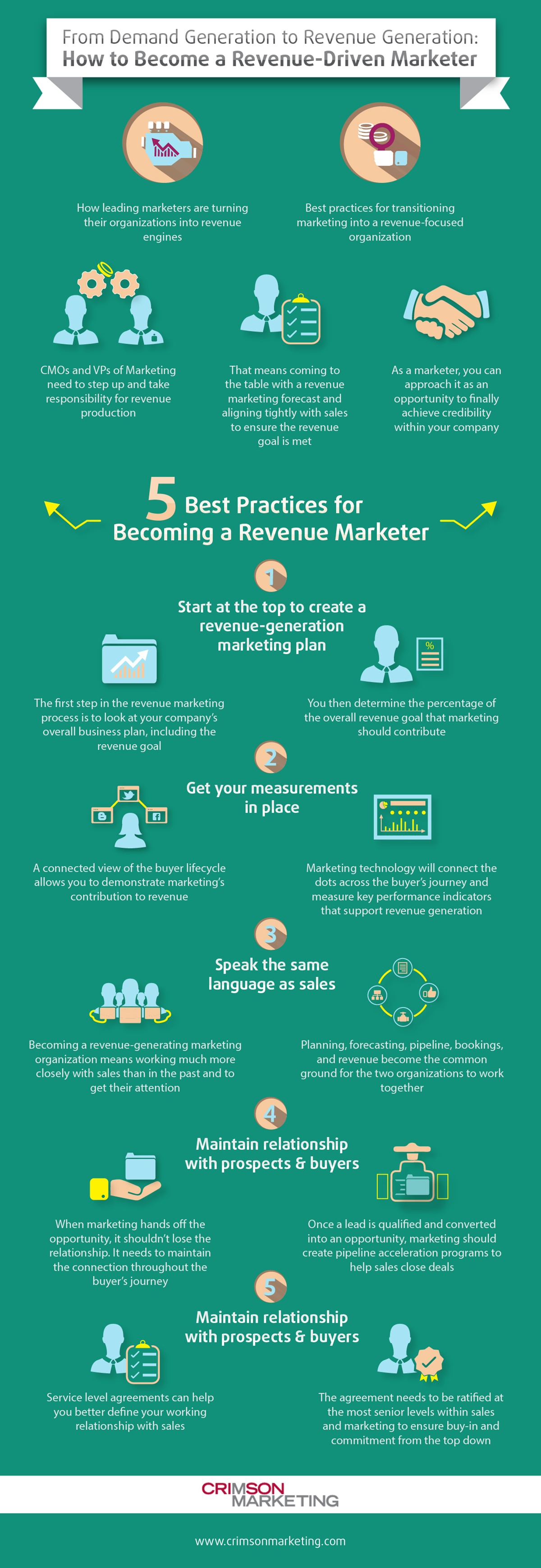The days of being grudgingly accepted as a necessary cost center are numbered for Marketing. Today, the writing is on the wall: Either demonstrate how Marketing will contribute to the company's top-line revenue growth... or be prepared to change careers.
CMOs and VPs of marketing need to step up and take responsibility for revenue production. That means coming to the table with a revenue marketing forecast and aligning tightly with Sales to ensure the revenue goal is met.
Some companies are even assigning revenue quotas to Marketing and compensating marketing executives on meeting those quotas. Your company might be next.
As a marketer, you can view this trend as a negative, or you can approach it as an opportunity to finally achieve credibility within your company, especially with the executive suite. Showing a return on investment is the entrée to a strategic place at the executive table.
The big question is how to make the transition from being a demand generation-focused organization to becoming a revenue-generating organization.
There is no cookie-cutter solution, but there are proven best-practices being used by savvy marketers to successfully drive revenue-focused marketing (also see the infographic at the end of this article).
Five Best-Practices for Becoming a Revenue Marketer
1. Start at the top to create a revenue-generation marketing plan
The first step in the revenue marketing process is to look at your company's overall business plan, including the revenue goal. Your marketing plan should align with the business priorities and goals for your company as set out in the company plan.
You then determine the percentage of the overall revenue goal that marketing should contribute. Though the percentage will vary by industry, in our experience it's not uncommon to see targets starting at 30% or even higher. Based on that target, you can set performance goals for the demand waterfall, including the number of visitors, leads, opportunities, and closed deals you need to make your revenue quota.
2. Get your measurements in place
Many marketing departments don't know how to focus on revenue as a goal because they don't understand how they can measure it. You must have the proper systems in place so that you're able to track a lead from the moment it comes in all the way through the buying cycle, when that buyer purchases, renews, or cancels.
A connected view of the buyer lifecycle allows you to demonstrate marketing's contribution to revenue.
The problem is that many marketers have disjointed systems or they lack the right marketing solutions altogether, which limits their ability to track performance across the buying cycle. A VentureBeat study found that only 20% of large companies use marketing automation today.
Marketing technology will be imperative to connect the dots across the buyer's journey and measure key performance indicators that support revenue generation.
3. Speak the same language as Sales
Becoming a revenue-generating marketing organization means working much more closely with Sales than in the past. And to get their attention, you need to speak their language. When you talk about open rates, lead generation, and automated nurture campaigns, Sales hears "marketing-speak." Don't talk about leads. Talk about qualified opportunities and closed business.
As marketing organizations make the transition into revenue generation, the shift to speaking the same language will start happening organically. Planning, forecasting, pipeline, bookings, and revenue become the common ground for the two organizations to work together
4. Maintain the relationship with prospects and buyers
It's no longer acceptable to hand off the lead or opportunity and walk way. Marketing has to take responsibility for working with Sales to find ways to help move the buying process along. When Marketing hands off the opportunity, it shouldn't lose the relationship. It needs to maintain the connection throughout the buyer's journey.
Once a lead is qualified and converted into an opportunity, Marketing should create pipeline acceleration programs to help Sales close deals. For instance, marketing could create an individualized program for opportunities that have been stuck for 30 days or more, to help move them forward.
5. Define service-level agreements
Part of committing to a partnership is agreeing on how you'll work together. Service-level agreements can help you better define your working relationship with Sales. For example, you might decide that Marketing will provide only leads that meet certain criteria as an opportunity, then once that opportunity is handed to sales, Sales must make contact within 48 hours, else the opportunity reverts to Inside Sales.
The point is to agree on when an opportunity will be handed off, how long Sales will hold it, and what happens when the required action does not occur. The agreement needs to be ratified at the most senior levels within Sales and Marketing to ensure buy-in and commitment from the top down.
It's All About Revenue Now
Nearly every marketing executive is feeling the pressure to show a financial return. But signing up for a revenue number should be viewed as a positive: It's an opportunity to expand Marketing's influence and justify a larger budget.
As you build your revenue engine, you can scale your success, grow Marketing's contribution to the bottom line, and make that seat at the executive table permanent.
(This article was inspired by my podcast interview with Kerry Langstaff, vice-president of marketing at Xignite.)





